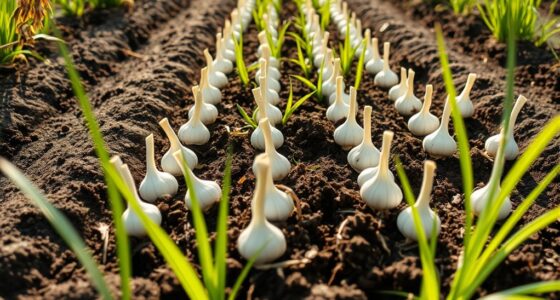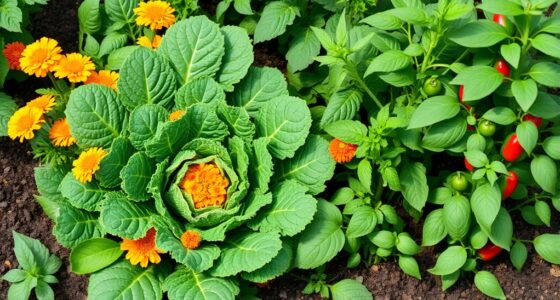To rotate crops for better yields, start by planning a sequence that includes different types of crops. Use legumes to enhance soil nitrogen and improve fertility. Consider systems like the three-field or four-field method to diversify crop types and disrupt pest cycles. Integrate cover crops during off-seasons to maintain soil health. This approach boosts productivity and sustainability on your farm. Want to explore more effective strategies? There's plenty more to discover!
Key Takeaways
- Implement a planned crop rotation sequence of three to eight years to enhance soil health and reduce pest cycles.
- Incorporate nitrogen-fixing legumes to naturally replenish soil fertility, supporting subsequent heavy-feeding crops.
- Utilize diverse crop rotations, such as three-field or four-field systems, to disrupt pests and improve biodiversity.
- Include cover crops during off-seasons to enhance soil structure, organic matter, and nutrient cycling.
- Choose drought-resistant varieties and adapt to environmental changes to maintain stable yields during dry periods.
Understanding Crop Rotation

When you immerse yourself in crop rotation, you'll find it's a smart strategy for maintaining soil health and productivity. This practice involves planting different crops in a planned sequence, which helps restore soil nutrients and improve soil fertility over time.
By alternating crops with varying nutrient needs, you enhance nutrient cycling and reduce reliance on synthetic fertilizers. Incorporating nitrogen-fixing legumes is key, as they naturally replenish soil nitrogen levels for future crops.
Well-thought-out crop rotation strategies typically span three to eight years, promoting effective pest control and healthy ecosystems.
With careful planning and documentation, you can create a diverse crop system that supports sustainable agriculture and ultimately boosts your yields while nurturing the land.
Benefits of Crop Rotation for Farmers

Crop rotation offers farmers a range of significant benefits that can transform their agricultural practices. By implementing crop rotation, you can increase yields by an impressive 37% compared to traditional double-cropped systems, enhancing productivity overall.
Experience a remarkable 37% boost in yields with crop rotation, revolutionizing your agricultural practices for enhanced productivity.
This method helps improve soil fertility, especially when you incorporate nitrogen-fixing legumes, which replenish essential nutrients for subsequent crops. Additionally, rotating crops breaks the cycles of pests and diseases, leading to healthier crops and reducing reliance on chemical fertilizers.
Diverse crop sequences not only promote pollinator diversity, boosting fruit and seed production, but also help you mitigate risks associated with unpredictable weather events.
Embracing crop rotation benefits your farm's sustainability while maximizing your returns in the long run.
Benefits of Crop Rotation for the Land

By adopting crop rotation, you not only enhance your farm's productivity but also greatly benefit the land itself.
Here are three key advantages of this practice:
- Soil Fertility and Nutrient Balance: Planting diverse crops, especially legumes, replenishes depleted nutrients, enhancing soil fertility and maintaining a better nutrient balance.
- Improved Soil Structure and Water Retention: Alternating between shallow- and deep-rooted plants helps improve soil structure, allowing for better water infiltration and retention while reducing soil erosion.
- Pest and Disease Management: Crop rotation disrupts pest and disease cycles, which helps reduce reliance on pesticides and fosters greater biodiversity, creating a healthier ecosystem for your land.
Embracing crop rotation guarantees a sustainable and prosperous agricultural environment.
Different Types of Crop Rotations

When it comes to crop rotations, you'll find several effective systems to choose from.
The three-field and four-field systems each offer unique benefits, focusing on crop diversity and soil health.
Understanding these strategies can help you optimize your yields and maintain sustainable farming practices.
Three-Field System
The three-field system offers a practical approach to crop rotation that maximizes land use and promotes soil health. By using this method, you can effectively enhance your crop rotation cycle and achieve sustainable agriculture.
Here's how it works:
- Plant one-third of your land with a winter crop.
- Utilize another third for a spring-sown crop.
- Leave the final third fallow or plant nitrogen-fixing crops, like legumes.
This rotation reduces disease and pest pressure, improves soil fertility, and enhances biodiversity.
Legumes boost soil nitrogen, benefiting subsequent crops such as corn and barley. Historical data shows that the three-field system can increase overall yields by up to 25%, creating healthier ecosystems and promoting soil structure for a more productive future.
Four-Field System
Crop rotation can take many forms, and one effective method is the four-field system. In this approach, you rotate four different crops, often including two winter crops and two spring-sown crops. This helps reduce soil erosion and pest damage while enhancing soil fertility.
Incorporating legumes into your rotation is key, as they naturally fix nitrogen, boosting soil health for future crops. By alternating crops, you not only optimize the nutrient balance but also greatly increase long-term yields compared to continuous cropping.
Furthermore, the four-field system minimizes your reliance on chemical fertilizers and pesticides, making your agricultural practices more sustainable. Embracing this method can lead to healthier soils and more productive harvests.
Crop Sequence Strategies
To maximize your agricultural success, implementing effective crop sequence strategies is essential.
Here are three popular crop rotation plans you can adopt:
- Three-Field System: Rotate winter crops, spring-sown crops, and incorporate fallow or nitrogen-fixing crops to replenish soil nutrients and reduce pests and diseases.
- Four-Field System: Include two winter crops and two spring-sown crops, such as legumes, to minimize erosion and enhance long-term viability while boosting crop yield.
- Cover Crops: Integrate these into your rotation to improve soil fertility by adding organic matter and optimizing soil health.
Crop Selection and Sequence

When selecting crops, you need to assess their compatibility and timing to maximize productivity.
Consider how each crop interacts with others in your rotation and align their planting schedules for ideal growth.
Crop Compatibility Assessment
Understanding crop compatibility is essential for successful rotation planning, as it directly influences soil health and productivity.
To assess compatibility, consider the following:
- Nutrient Requirements: Rotate heavy feeders like corn with lighter feeders such as beans to balance soil nutrients.
- Nitrogen-Fixing Legumes: Include crops like peas and beans to enrich the soil with nitrogen, benefiting future crops.
- Root Depth Differences: Utilize deep-rooted plants, such as alfalfa, to aerate the soil, improving nutrient availability for shallower-rooted crops.
Avoid planting related crops in succession to prevent soil-borne diseases.
Planning your crop sequence according to seasonal growth cycles guarantees peak yield and compatibility, creating a thriving garden environment.
Seasonal Timing Considerations
Seasonal timing plays a pivotal role in your crop rotation strategy, as aligning planting dates with the specific growing seasons of your chosen crops maximizes yields.
By selecting crops based on seasonal temperature ranges, you can guarantee ideal growth conditions. For example, plant cool-season crops like peas and lettuce in early spring, while reserving warm-season crops like tomatoes and corn for late spring and summer.
Incorporating nitrogen-fixing legumes during specific seasons replenishes soil nutrients, benefiting heavy feeders planted afterward.
Utilizing a three-field or four-field rotation system lets you alternate between winter and spring crops, enhancing soil fertility.
Additionally, monitoring regional climate patterns allows for better crop selection, guaranteeing resilience against drought or excessive rainfall, ultimately improving your yield.
Incorporating Legumes in Rotation

Incorporating legumes in your crop rotation can greatly boost soil health and fertility. These plants naturally fix nitrogen, enhancing soil fertility for future crops.
Here's how they help:
- Improved Soil Structure: Legumes like beans and peas improve soil structure, promoting better nutrient cycling.
- Enhanced Microbial Diversity: They increase microbial diversity, which is crucial for maintaining healthy ecosystems in your soil.
- Reduced Reliance on Synthetic Fertilizers: By adding nitrogen and nutrients, legumes can lessen your need for synthetic fertilizers, cutting costs.
Rotating legumes with nutrient-extracting crops like corn leads to higher yields and healthier plants while breaking pest and disease cycles, making this practice an integral part of effective crop rotation.
Managing Risks and Challenges

While crop rotation offers numerous benefits, effectively managing the associated risks and challenges is vital for success. You need to carefully plan your crop rotation to minimize pest and disease buildup and adapt to fluctuating market demands. Incorporating drought-resistant crops helps combat climate variability and guarantees consistent yields. Integrated weed management strategies will also control weed populations and reduce herbicide resistance risks. Additionally, maintaining proper water sources is crucial for crop health and yield stability during dry periods.
| Risks/Challenges | Solutions | Benefits |
|---|---|---|
| Pest and disease buildup | Rotate crops regularly | Minimized infestations |
| Market demands | Include high-value crops | Enhanced profitability |
| Environmental changes | Use drought-resistant varieties | Improved resilience |
Implementing Crop Rotation Strategies

Successfully managing risks and challenges sets the stage for effective crop rotation strategies.
To enhance your soil fertility and optimize yields, consider these steps:
- Plan Your Crop Sequence: Align crops based on their nutrient requirements. Follow heavy feeders with nutrient-replenishing crops like legumes to maintain soil health.
- Diversify Your Crops: Rotate crops by family, avoiding similar plants in succession. This minimizes pest pressure and disease risks, contributing to overall plant health.
- Incorporate Cover Crops: Use cover crops like cereal rye or clover during off-seasons to improve organic matter and nutrient cycling.
Frequently Asked Questions
How Can Crop Rotation Increase Yield?
Crop rotation can increase your yield by enhancing soil health and nutrient availability.
By alternating crops, you disrupt pest and disease cycles, leading to healthier plants. Including legumes in your rotation replenishes nitrogen levels, boosting productivity.
Different root structures improve soil aeration and water infiltration, allowing better access to nutrients.
What Is the Best Way to Rotate Crops?
Envision this: you're a medieval farmer, but instead of planting the same crops year after year, you mix it up.
The best way to rotate crops is by alternating different plant families. This keeps your soil healthy and nutrients balanced.
Incorporate nitrogen-fixing legumes to boost soil fertility, and don't forget to track what you've planted.
Adapting your choices based on market trends and climate will guarantee successful, sustainable farming.
What Is the Best Practice for Crop Rotation?
The best practice for crop rotation involves planning diverse crop sequences that enhance soil health and maximize yields.
You should alternate heavy-feeding crops with nitrogen-fixing legumes to maintain soil fertility.
Implementing systems like three-field or four-field rotations helps reduce pests and diseases.
Regular soil testing guarantees you're meeting nutrient needs, while monitoring environmental factors allows you to adjust your plan effectively.
With careful management, you'll create a resilient and productive farming system.
Does Crop Rotation Increase Profit?
Imagine your field as a canvas, each crop a vibrant color adding depth and richness.
By rotating your crops, you're not just painting; you're enhancing the soil's health and fertility. This leads to lower costs for fertilizers and boosts your overall profits.
You'll find that diverse crops not only protect against pests but also buffer against market fluctuations, creating a more stable financial future for you and your agricultural endeavors.
Conclusion
Incorporating crop rotation into your farming practices is like weaving a tapestry of resilience and productivity. Just as nature thrives on diversity, your yields will flourish when you embrace this ancient technique. By rotating crops, you're not only nurturing the soil but also securing your harvest against pests and diseases. So, take a cue from the cycles of nature and start planning your rotations today; your fields will thank you with bountiful returns.










